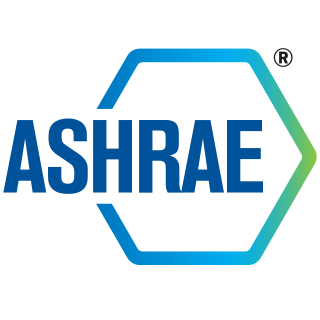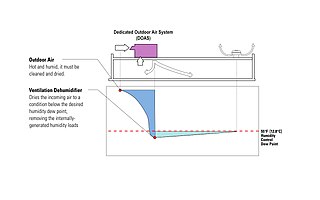Related Research Articles

Energy Star is a program run by the U.S. Environmental Protection Agency (EPA) and U.S. Department of Energy (DOE) that promotes energy efficiency. The program provides information on the energy consumption of products and devices using different standardized methods. The Energy Star label is found on more than 75 different certified product categories, homes, commercial buildings, and industrial plants. In the United States, the Energy Star label is also shown on the Energy Guide appliance label of qualifying products.

Leadership in Energy and Environmental Design (LEED) is a green building certification program used worldwide. Developed by the non-profit U.S. Green Building Council (USGBC), it includes a set of rating systems for the design, construction, operation, and maintenance of green buildings, homes, and neighborhoods, which aims to help building owners and operators be environmentally responsible and use resources efficiently.
Building performance is an attribute of a building that expresses how well that building carries out its functions. It may also relate to the performance of the building construction process. Categories of building performance are quality, resource savings and workload capacity. The performance of a building depends on the response of the building to an external load or shock. Building performance plays an important role in architecture, building services engineering, building regulation, architectural engineering and construction management. Furthermore, improving building performance is important for addressing climate change, since buildings account for 30% of global energy consumption, resulting in 27% of global greenhouse gas emissions. Prominent building performance aspects are energy efficiency, occupant comfort, indoor air quality and daylighting.

The Chartered Institution of Building Services Engineers is an international professional engineering association based in London, England that represents building services engineers. It is a full member of the Construction Industry Council, and is consulted by government on matters relating to construction, engineering and sustainability. It is also licensed by the Engineering Council to assess candidates for inclusion on its Register of Professional Engineers.
This article provides examples of green building programs in the United States. These programs span the public, private, and non-profit sectors, and all have the goal of increasing energy efficiency and the sustainability of the built environment.
Daylight harvesting systems use daylight to offset the amount of electric lighting needed to properly light a space, in order to reduce energy consumption. This is accomplished using lighting control systems that are able to dim or switch electric lighting in response to changing daylight availability. The term Daylight Harvesting has become the standard in the fields of lighting, sustainable architecture, and active daylighting industries.

A trickle vent is a very small opening in a window or other building envelope component to allow small amounts of ventilation in spaces intended to be naturally ventilated when major elements of the design – windows, doors, etc., are otherwise closed. Trickle vents are used extensively in Europe and are integrated into window frames to provide minimum ventilation requirements for naturally ventilated spaces.
Green building on college campuses is the purposeful construction of buildings on college campuses that decreases resource usage in both the building process and also the future use of the building. The goal is to reduce CO2 emissions, energy use, and water use, while creating an atmosphere where students can be healthy and learn.
The International Green Construction Code (IGCC) is a set of guidelines that aim to improve the sustainability and environmental performance of buildings during their design, construction, and operation. It was introduced by the International Code Council (ICC), a non-profit organization that provides building safety and fire prevention codes for the United States and other countries. It is a model code designed to be mandatory where it is implemented.

A dedicated outdoor air system (DOAS) is a type of heating, ventilation and air-conditioning (HVAC) system that consists of two parallel systems: a dedicated system for delivering outdoor air ventilation that handles both the latent and sensible loads of conditioning the ventilation air, and a parallel system to handle the loads generated by indoor/process sources and those that pass through the building enclosure.
LEED for Neighborhood Development (LEED-ND), where "LEED" stands for Leadership in Energy and Environmental Design, is a United States-based rating system that integrates the principles of smart growth, urbanism, and green building into a national system for neighborhood design. LEED certification provides independent, third-party verification that a development's location and design meet accepted high levels of environmentally responsible, sustainable development.

United States building energy codes are a subset of building codes that set minimum requirements for energy-efficient design and construction for new and renovated buildings. The intent of these energy codes is to moderate and reduce energy use and emissions throughout the lifetime of a building. Energy code provisions may include various aspects of building design and construction, such as: HVAC systems, building envelope, electrical, and lighting systems. There are building energy codes for both commercial and residential buildings. However, just as the United States does not have a national building code, it also does not have a national building energy code; rather, state, and local governments choose to adopt—and potentially revise—national model energy codes and standards. Consequently, building energy codes, and building codes in general, vary between states and jurisdictions.
ANSI/ASHRAE/IES Standard 90.1: Energy Standard for Buildings Except Low-Rise Residential Buildings is an American National Standards Institute (ANSI) standard published by ASHRAE and jointly sponsored by the Illuminating Engineering Society (IES) that provides minimum requirements for energy efficient designs for buildings except for low-rise residential buildings. The original standard, ASHRAE 90, was published in 1975. There have been multiple editions to it since. In 1999 the ASHRAE Board of Directors voted to place the standard on continuous maintenance, based on rapid changes in energy technology and energy prices. This allows it to be updated multiple times in a year. The standard was renamed ASHRAE 90.1 in 2001. It has since been updated in 2004, 2007, 2010, 2013, 2016, and 2019 to reflect newer and more efficient technologies.
Green Building Initiative (GBI) is a 501(c)(3) nonprofit organization that owns and administers the Green Globes green building assessment and certification in the United States and Canada. It was established in 2004 and is headquartered in Portland, Oregon.
Lighting Power Density (LPD) is a lighting power requirement defined in North America by the American National Standards Institute (ANSI), American Society of Heating, Refrigerating and Air-Conditioning Engineers (ASHRAE), and the Illuminating Engineering Society of North America (IESNA) Lighting subcommittee.

The American Society of Heating, Refrigerating and Air-Conditioning Engineers is an American professional association seeking to advance heating, ventilation, air conditioning and refrigeration (HVAC&R) systems design and construction. ASHRAE has over 50,000 members in more than 130 countries worldwide.
Cooling load is the rate at which sensible and latent heat must be removed from the space to maintain a constant space dry-bulb air temperature and humidity. Sensible heat into the space causes its air temperature to rise while latent heat is associated with the rise of the moisture content in the space. The building design, internal equipment, occupants, and outdoor weather conditions may affect the cooling load in a building using different heat transfer mechanisms. The SI units are watts.

Moisture Removal Efficiency (MRE) is a measure of the energy efficiency of any dehumidification process. Moisture removal efficiency is the water vapor removed from air at a defined inlet air temperature and humidity, divided by the total energy consumed by the dehumidification equipment during the same time period, including all fan and pump energy needed to move air and fluids through the system.
Healthy building refers to an emerging area of interest that supports the physical, psychological, and social health and well-being of people in buildings and the built environment. Buildings can be key promoters of health and well-being since most people spend a majority of their time indoors. According to the National Human Activity Pattern Survey, Americans spend "an average of 87% of their time in enclosed buildings and about 6% of their time in enclosed vehicles."

Green building certification systems are a set of rating systems and tools that are used to assess a building or a construction project's performance from a sustainability and environmental perspective. Such ratings aim to improve the overall quality of buildings and infrastructures, integrate a life cycle approach in its design and construction, and promote the fulfillment of the United Nations Sustainable Development Goals by the construction industry. Buildings that have been assessed and are deemed to meet a certain level of performance and quality, receive a certificate proving this achievement.
References
Notes
- ↑ DUNCAN, WALKER (July 9, 2013). "CandleRay Wants to Help You Join the 'Lighting Revolution'". Southern Alpha. Archived from the original on 29 July 2013. Retrieved 29 July 2013.
- ↑ "Energy Star Campaign Resources" . Retrieved 29 July 2013.
- ↑ "GreenRighting". Archived from the original on 29 September 2013. Retrieved 29 July 2013.